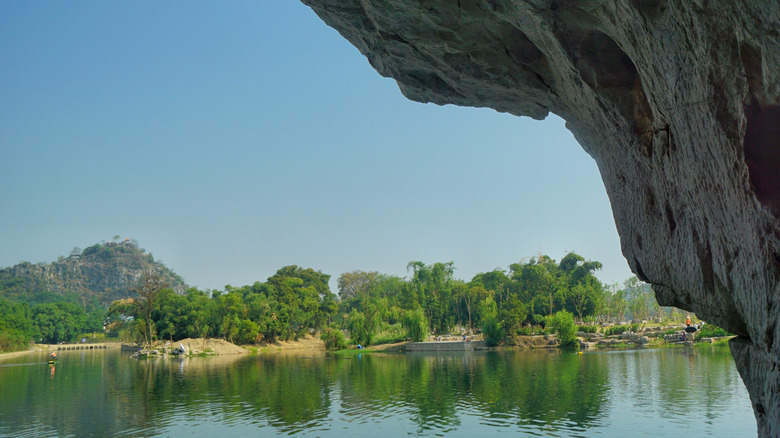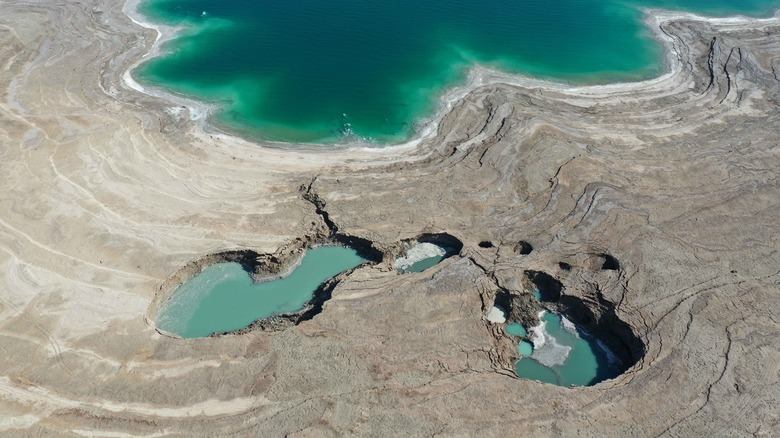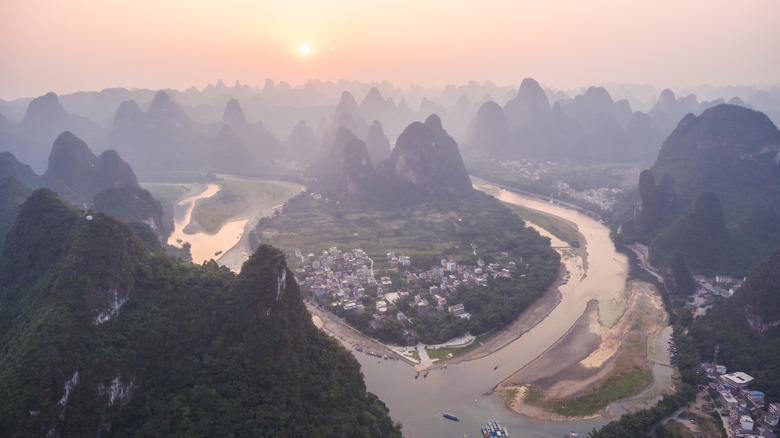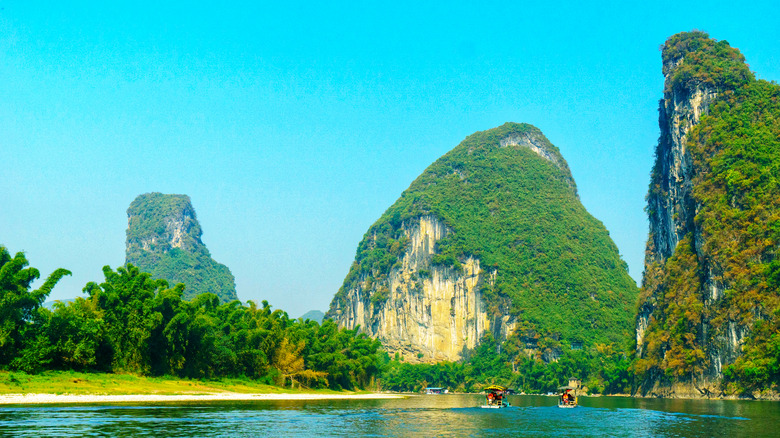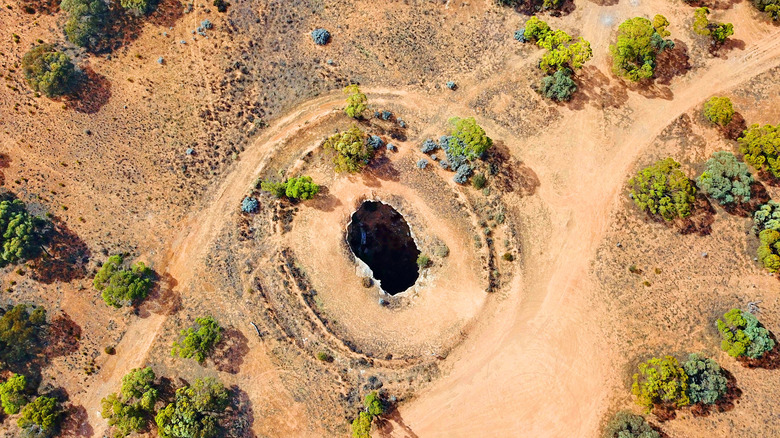A Giant Sinkhole In China Led To The Discovery Of A Forest
In China's Guangxi region, located just above Vietnam, grassy mountains and rice terraces stretch as far as the eye can see. Forests cover one-fourth of the region, where oranges, anise, and betel palm grow alongside roaming water buffalo, bison, and a type of monkey called a gibbon (via Britannica). In the Li River to the northeast, fishermen train a type of bird called cormorants to hunt for fish, a practice originating in ancient China that has been used for thousands of years, according to The Atlantic. Threading a sort of lasso across their gullets so that they can't swallow large fish, the fishermen let the birds do the work before reeling them back in and collecting their spoils.
But beneath the Earth's surface in this rural landscape lies something equally as mystical, and because of the way the land forms there, we are sometimes privy to peaks within.
How sinkholes form
The topography in this region — known as karst — is predominantly made up of limestone, which is porous and allows lots of water to pass through. Over thousands of years, water seeps through the soil, absorbing carbon dioxide and other chemicals that make it slightly acidic, according to St. Johns River Water Management. As this acidic water passes through the soil, it gradually erodes the landscape, forming rivers and cavities that travel toward the center of the Earth. Regions with some aspects of karst topography that don't involve the dissolution of land are called pseudokarst, per ScienceDirect. Eventually, these regions collapse, forming a sinkhole.
Human activity can accelerate the development of a sinkhole, and droughts exacerbated by warming temperatures and climate change can make them more likely to form. Additionally, when humans drill wells or pump groundwater from the Earth in large quantities without letting it recharge with precipitation, it can make sinkholes form where they wouldn't naturally.
A 'heavenly pit'
In China's Guangxi region, massive amounts of limestone give way to many large sinkholes connected to underground labyrinths of streams. Across the land, natural springs, caves, and sinkholes are common, according to the National Park Service. In fact, this region in China is so rich in this type of landscape that it was listed as a Unesco World Heritage Site in 2007, according to the World Heritage Convention. According to Unesco, the region "contains the most spectacular, scientifically significant and representative series of karst landforms and landscapes of South China" and "constitutes the world's premier example of humid tropical to subtropical karst: one of our planet's great landscapes."
In Mandarin, giant sinkholes across the region are called "tiankeng," which translates to "heavenly pit," because the view from below is so incredible, according to Smithsonian Magazine. Overall, the outlet says there are estimated to be 30 such sinkholes that have been discovered there.
The new sinkhole
In May, a team of Chinese scientists was exploring this region and discovered a new sinkhole, according to Live Science. Rappelling all 630 feet down into the mouth of the cave, the spelunkers took several hours to reach the bottom of the cavity, which stretches almost 500 feet wide, close to 1,000 feet in length, and has a total volume of 176 million cubic feet, according to the Chinese government's state-owned news agency, Xinhua.
When the climbers' feet finally touched solid ground again, they found one of the most incredible things discovered in sinkholes: a rich forest canopy, including undergrowth as tall as them and ancient growth trees that stretched more than 1,000 feet tall, according to Smithsonian Magazine. In an interview with The Washington Post, a karst researcher said these previously unexplored forests could be home to several plant and animal species that have never been seen before. Even though the cave is about as tall as the Space Needle in Seattle, Washington, the cave's mouth is so wide that enough light can seep in to support life, per TimeOut.
The region's other sinkholes
In northern China, the world's deepest sinkhole was formed over the Difeng cave in the Tiankeng Difeng National Park, according to ScienceAlert. According to the outlet, the Xiaozhai Tiankeng sinkhole, falling 2,054 feet below the Earth's surface, is thought to have formed through the passage of a giant underground river across a period of 2 million years.
In 2018, another spelunking team discovered another enormous sinkhole in the region that was about half as deep at 387 feet, per ScienceAlert. What this team found when they lowered themselves to the bottom was a twisting maze with large stone craters and pillars, collapsed rocks, and cave pearls — small rocks that have been smoothed completely by the passage of water over thousands of years. The team is now undertaking a 3D imaging project of the cave to fully understand what all lies beneath the sinkhole's surface, as well as to give clues on how the sinkhole formed and how the cave formed.
The significance of karsts
Besides the excitement and scientific potential of discovering previously unknown landscapes hidden beneath the surface of the Earth, these landscapes also serve an important ecological function. Karst regions where "tiankengs" form are important for groundwater storage, and more than 700 million people across the globe drink water that is sourced from aquifers in these types of regions, according to AccuWeather. However, this porous nature is a double-edged sword because it also makes these landscapes more prone to pollutants seeping into deep layers of the Earth.
George Veni, the executive director of the National Cave and Karst Research Institute (NCKRI), told Live Science that karst aquifers are also "the only types of aquifers that you can pollute with solid waste" and that he has dredged up car batteries, "barrels of God-knows-what, and bottles of God-knows-what out of the active cave stream." Veni works in the U.S., where about one-quarter of the landscape is karst or pseudokarst landscape. Luckily, the newly discovered "tiankeng" in China hasn't seen the level of pollution of some U.S. karsts. At least not yet.
